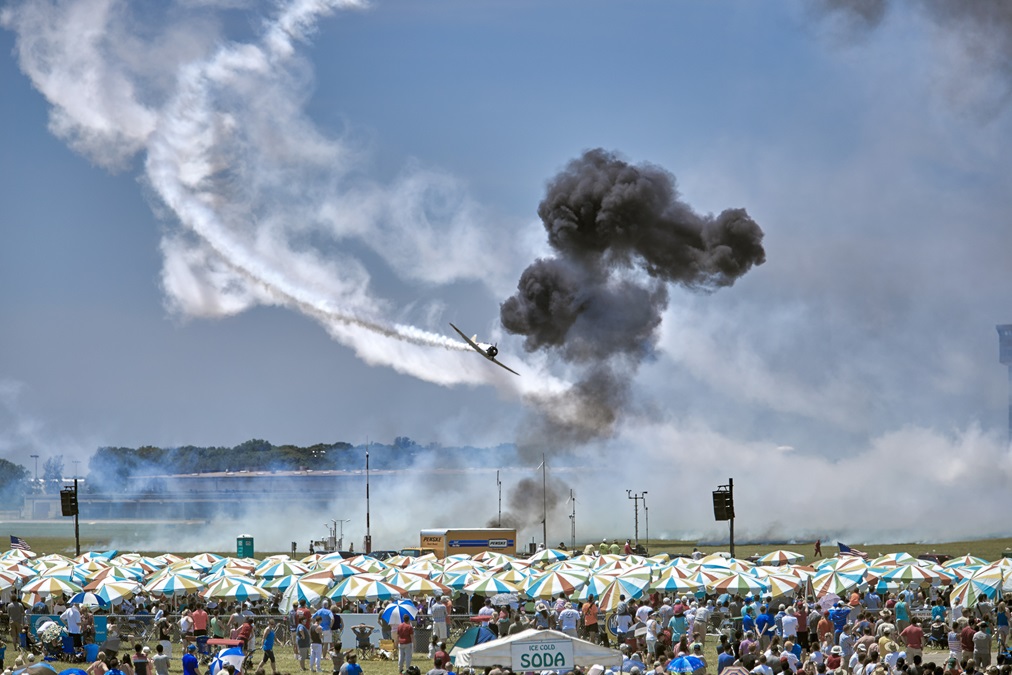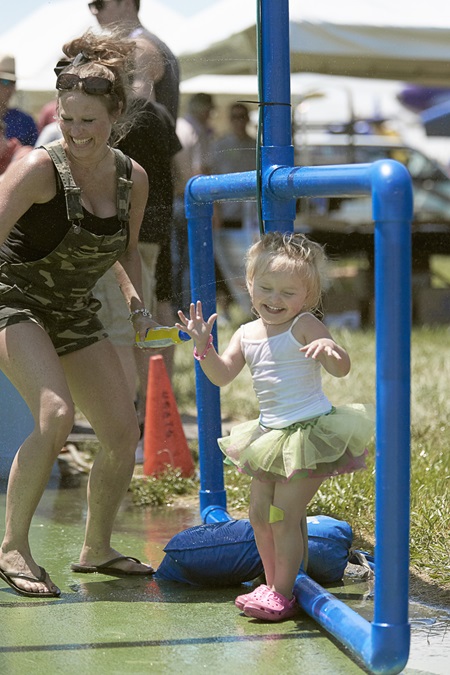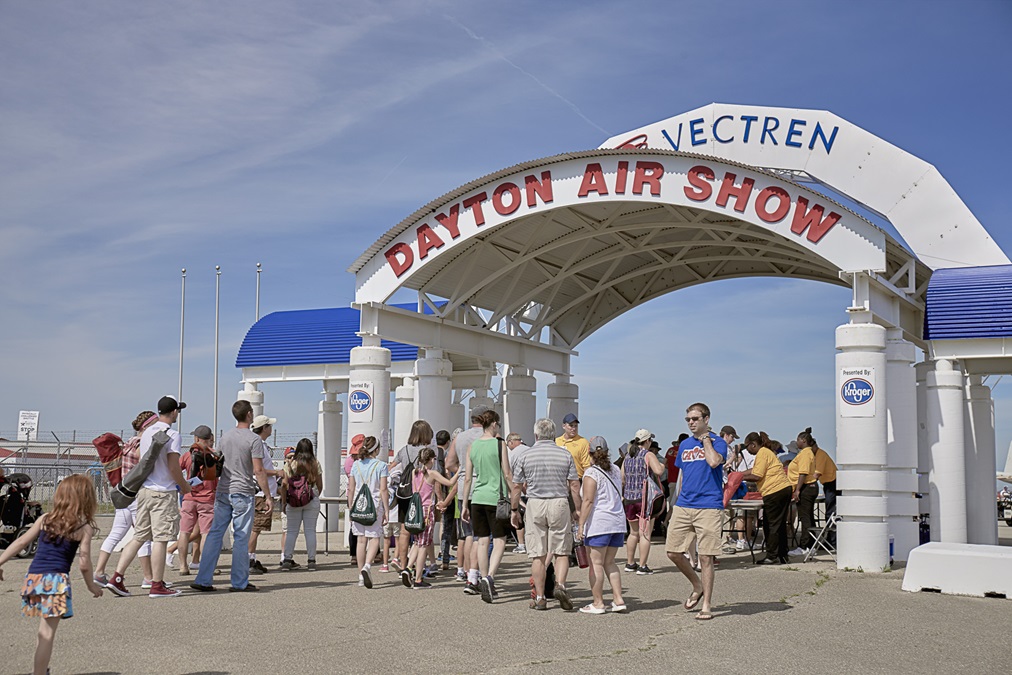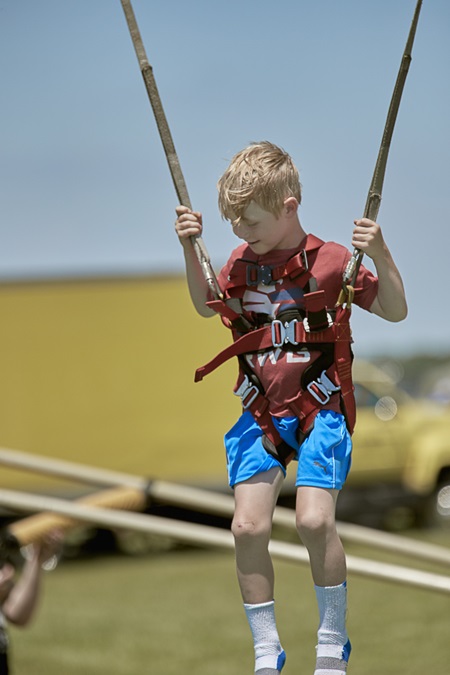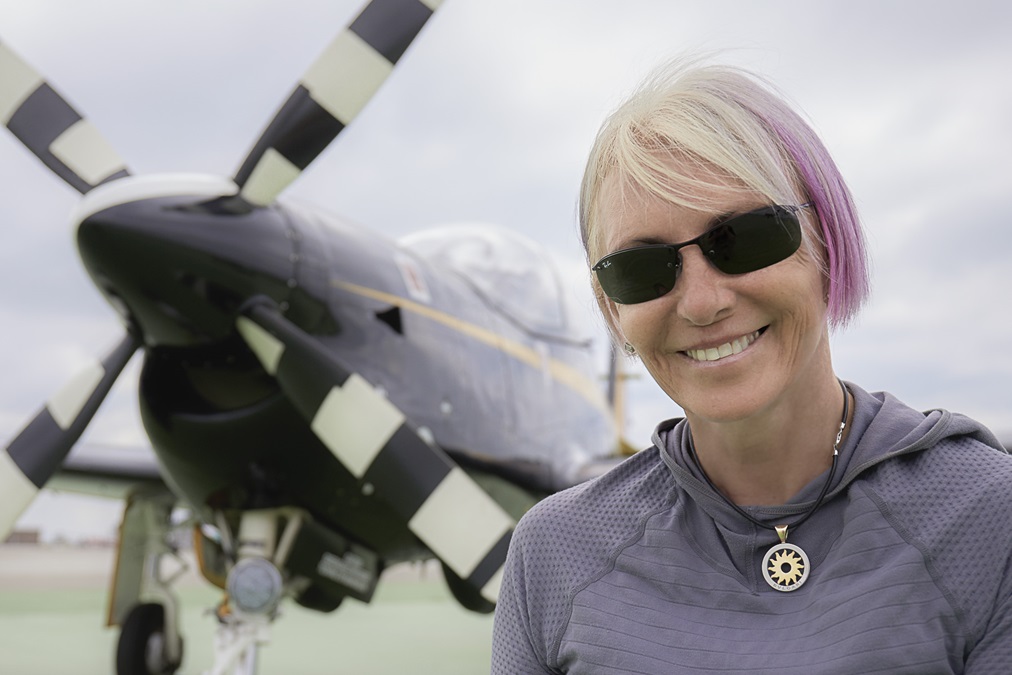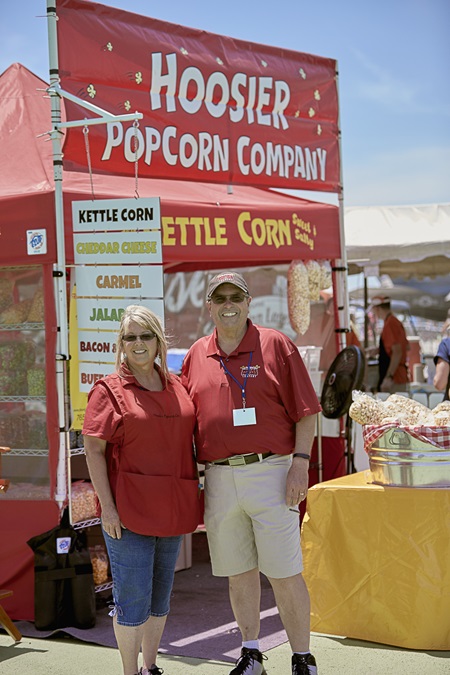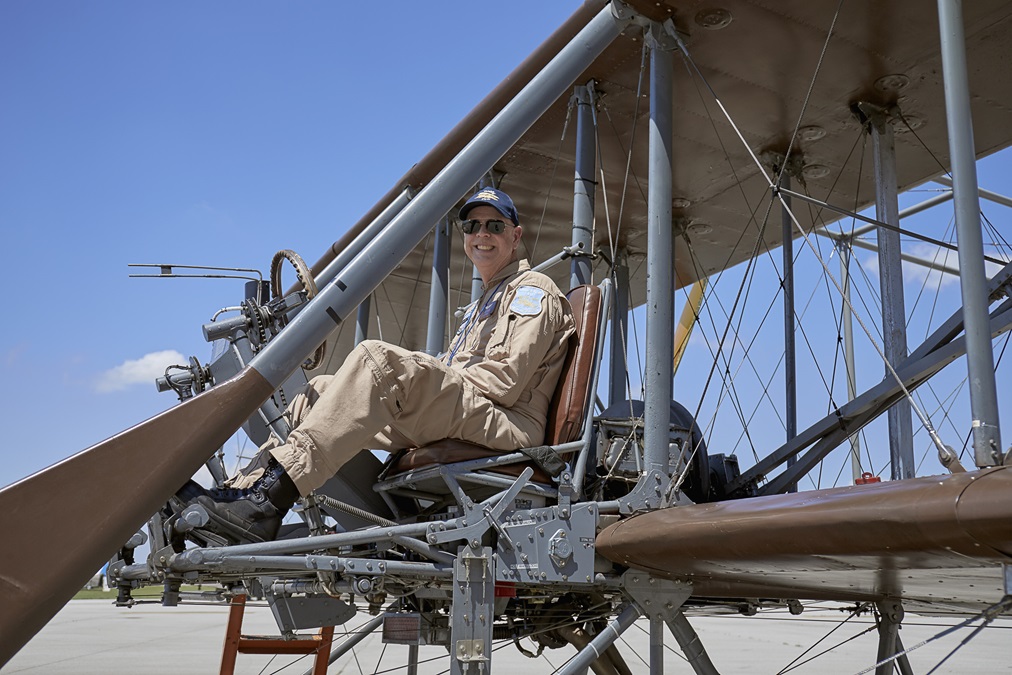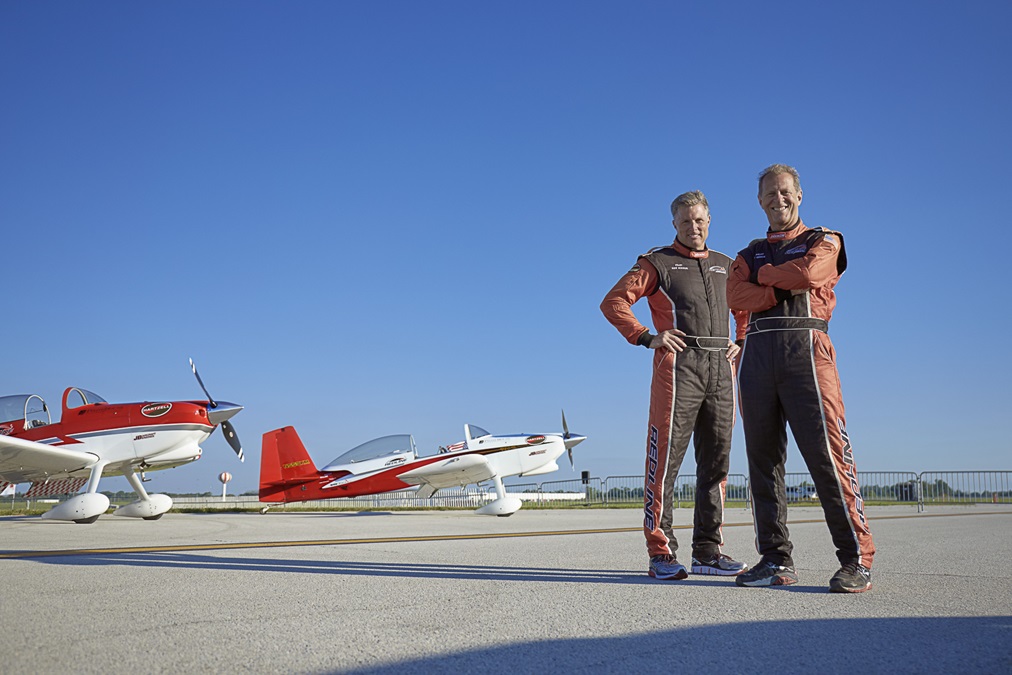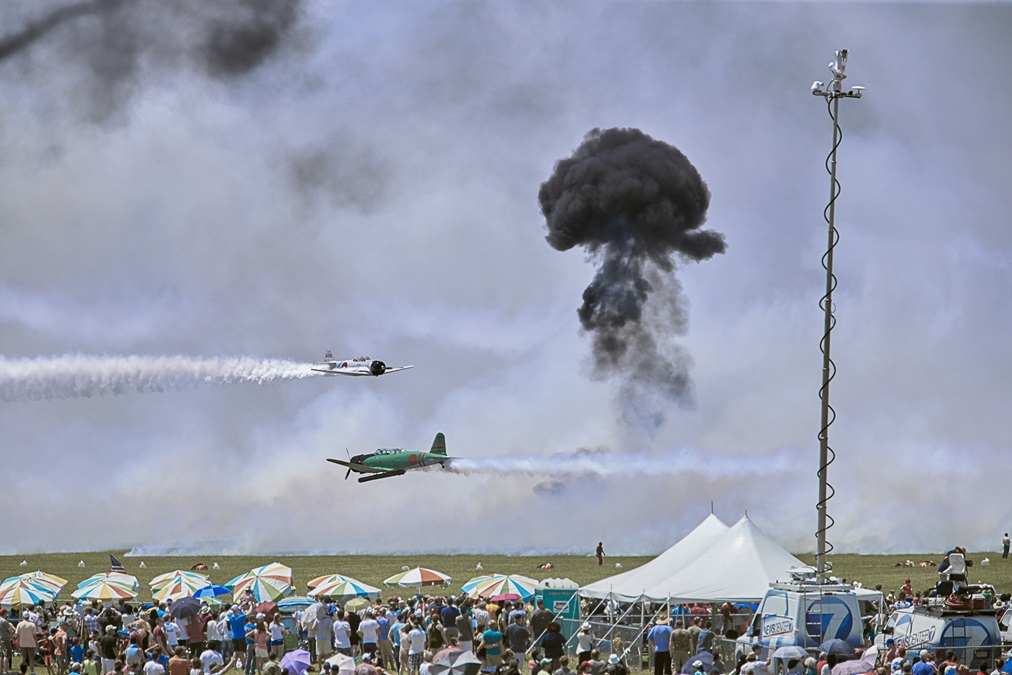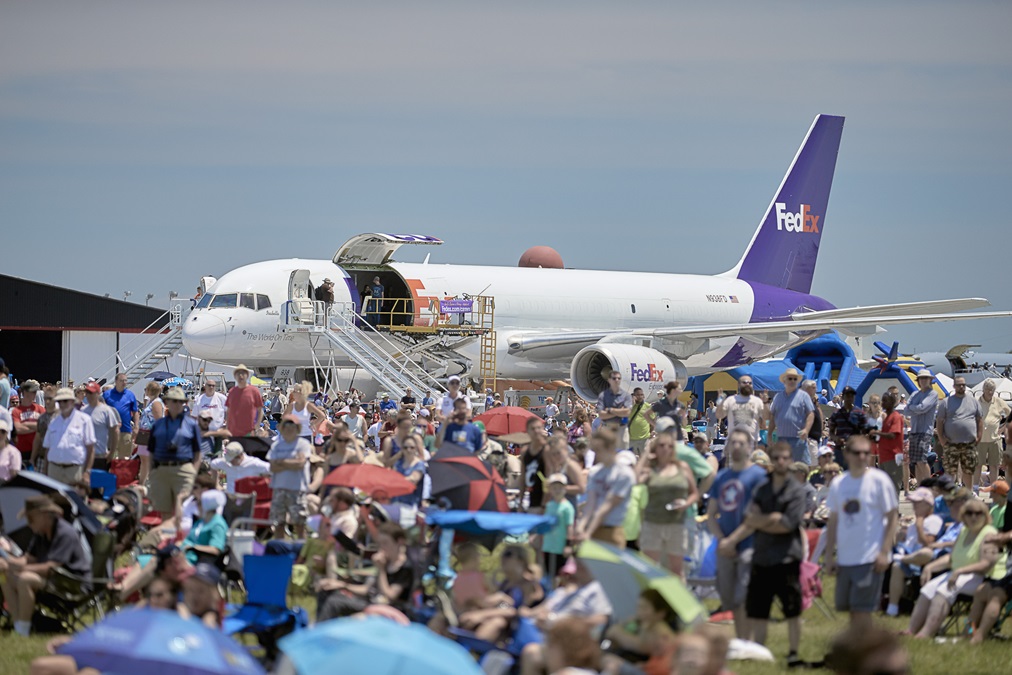Lights, camera, airshow
Behind the scenes at Dayton’s annual aviation event
The airshow opens in 27 hours. This final long day of setup sees constant movement: aircraft, golf carts, emergency vehicles, volunteers in red shirts, vendors. The hustle pauses as everyone stops to watch the arrival of two U.S. Navy F–35 Lightning stealth fighters. The volunteers are jubilant. Soon the F–35s will taxi to the ramp to be part of the static display, but only the volunteers got to see them in flight.
Since 1975, Dayton’s aviation party has drawn 50,000 to 70,000 spectators over two days in June for the Vectren Dayton Airshow presented by Kroger, as the event is formally known. They come to see the airshow acts—a dozen each day—and wander around the static display crammed with military and civilian airplanes. They buy food, T-shirts, and souvenirs; if all goes well, they head home at the end of a long day still talking about everything they’ve seen and heard.
This setup is in its final, frantic hours, but planning for the 2016 airshow kicked off two years earlier. That’s the window for locking down military acts such as the U.S. Navy Blue Angels or the U.S. Air Force Thunderbirds. Military jet precision teams draw crowds, and when they’re not on the roster, attendance suffers—as airshows discovered when federal budget sequestration grounded military teams and demonstration aircraft in 2013.
“People don’t realize” the extent of planning needed for the airshow, said Terry Grevious, executive director of Grevious and Associates. “The thing people focus on is the airshow itself and the main entertainment feature. There’s a lot that goes on all year round to get to that feature.” Grevious’s company produces the show for the United States Air & Trade Show, a not-for-profit corporation that is the governing organization.
The two-year advance booking gives his company plenty of time to market and produce the event. “We know we will have the Thunderbirds next summer, and we can plan that now,” he says. Once the main attraction is booked, civilian acts are added.
Then there are the challenges associated with obtaining corporate sponsorships, which help to keep the show within its $1.3 million budget and build a cushion for the years when weather or other factors hurt attendance.
“That is a year-round job,” Grevious says. “Sponsorships are not an easy sell. It takes a lot of work, a lot of back and forth, a lot of data that you share with the customer about the value [they] will get out of this.
“The show would not be self-sufficient if it were not for the sponsors,” Grevious says. “We would not make enough at the gate to cover our expenses. The chalets are nice, but they cost a lot of money to maintain. For us to make all of that work, sponsorships are key.”
Even with all the planning, weather is a wild card, and Dayton has its collective fingers crossed for sunshine. Remnants of a hurricane made the 2015 airshow a cold, drizzly washout, with just 32,000 attendees.
Special guests
On the morning before the show opens, the airshow performers gather for a briefing. They’ll be flying today for 1,700 special guests: children and family members hosted by A Special Wish Foundation. The lineup includes Sean D. Tucker; Redline Airshows; Tora! Tora! Tora!’s re-enactment of the bombing of Pearl Harbor; the U.S. Navy Leap Frogs parachute team; Melissa Pemberton (now Andrzejewski); and Patty Wagstaff.
Air boss Gary Hay calls the roll and reminds the group that “Safety will never take a backseat” to the performance. “If it’s not right, stop,” he says.
Absent from the room are members of the U.S. Navy Blue Angels. The precision jet team had been on the schedule, but on June 2, Capt. Jeff Kuss was killed when the jet he was flying crashed after takeoff during a practice flight in Smyrna, Tennessee. The team had been preparing for the Great Tennessee Airshow. The Blue Angels canceled several subsequent performances.
The show’s organizers expect that the Blue Angels’ cancellation could hurt attendance numbers by as much as 25 percent. The Navy is sending its F/A–18 Super Hornet to fly a demonstration, “and that helps a lot,” Grevious says. “I wish we could hire someone to replace the Blue Angels, but there’s nothing.”
Hay runs through the timing of temporary flight restrictions, obstructions near the aerobatic box, and procedures for lost communications. He says the weather looks good for the next few days. Hay closes the briefing with a request: “Please stop by the Kids’ Hangar and chat with some of our future aviators. Sign some autographs.”
The first airshow
The Wright B Flyer, a flyable lookalike that opens the airshow, is a symbol of Dayton’s deep connection to aviation—it’s the birthplace of Orville and Wilbur Wright and home of their airplane factory as well as Huffman Prairie, where the brothers conducted experimental flights in 1904. As the Wrights perfected their flying machines, people began turning up at Huffman Prairie to see them fly. Exhibitions held May 25 and 26, 1910, for members of the Dayton Aeroplane Club drew an estimated 2,000 to 3,000 spectators. They watched from the edges of the field and cars lined up on the roadway for a half-mile; vendors peddled sandwiches and ice cream to the crowd, according to Timothy R. Gaffney, director of communications for the National Aviation Heritage Alliance in Dayton.
“These weren’t airshows in the modern sense, but they were clearly exhibitions scheduled and performed for large groups, and they were the first ones involving airplanes in the Dayton region,” Gaffney says. “I think it’s fair to say that on May 25 and 26, 1910, the Dayton area saw its first airshow.”
The humblest of airplanes in the twenty-first-century airshow, the Wright B Flyer still draws a crowd when it’s a part of the static display.
“Because it is unique, the first question everyone asks is, ‘Does it fly?’ The answer is yes, quite a bit,” says Rich Stepler, chief pilot of the Wright B. He will fly the airplane, carrying airshow announcer Danny Clisham in the right seat, for the opening ceremony. Stepler flew it at a leisurely 50 knots to Dayton International, about 16 nautical miles from its home base, Dayton-Wright Brothers Airport. “Fifty is the magic number for this airplane,” he says. “We take off at 50, climb at 50, descend at 50, and we land at 50.” (See “Want to Fly the Wright Model B?” p. 63.)
Performers
The airshow performers head to their airplanes. Wagstaff has brought a Short Tucano—a Brazilian turboprop trainer with a 1,150-horsepower Garrett engine. “It’s really fun to fly,” she says. “Very maneuverable.” Her preparation for this show is the same as it would be for any performance, large or small: “You have to have the same mindset; you have to be in practice.”
The Redline Airshow team—Ken Rieder and Jon Thocker—are making their debut at Dayton. Each built the RV–8 that he flies. Rieder has built three; Thocker has built nine—yes, nine. He says he suffers from “empty hangar syndrome.”
Both are natives of Cincinnati, but Rieder learned to fly at Dayton’s Moraine Airpark. “I’ve been coming to this airshow since I was a kid, a teenager,” he says. “For me to be the performer this time is a real treat.”
Airshow announcer Rob Rieder is sharing duties with Clisham. “This is where I grew up in the airshow business,” Rieder says of Dayton. A former television personality (and the narrator of Sporty’s Learn to Fly videos), Rieder filled in at the last minute as an announcer at the Dayton airshow in 1978. He joined the International Council of Air Shows in 1995 and became a fulltime announcer in 2006. Dayton’s show is one of 24 events on his 2016 schedule. He once kept three bulging binders of scripts for every airshow act. “Now I have most everything committed to iPad,” he says. “I have literally saved 18 pounds of paper. I’m using two iPads for all my scripts at shows now.”
On with the show
As forecast, opening day of the airshow is clear and dry with low humidity. And the crowds come, streaming through the front gates in hats and sunglasses, carrying lawn chairs, water bottles, and sunscreen. Even without the Blue Angels, the final attendance will be more than 51,000.
That’s good news for vendors Vicki and Dave Griffin, owners of The Original Hoosier Popcorn Co. of Lafayette, Indiana. They hope to sell 6,000 bags of flavored popcorn to hungry crowds. Dave is too busy stirring a fragrant kettle to chat, but Vicki reveals that Dave is a sport pilot who earned his certificate in 2011. They both love airshows. Dave slipped off earlier to check out the airplanes in the static display.
“We both did,” Vicki says. “We love airplanes, and we usually attend [airshows] but we’ve never worked one. When we heard about the Dayton airshow, it’s a nice big event, we thought, ‘Let’s do it.’ We’re here and hoping to move on to [EAA AirVenture].”
Lawn chairs are arranged, cellphone cameras come out, and spectators grab coveted spots under the wings of a FedEx Boeing 757 to watch the afternoon show. As the action gets under way, people are still climbing a set of airstairs to see inside the cargo jet. A FedEx employee in a purple shirt is posted by airstairs on the other side, there to lend a hand or prevent errant visitors from trying to scale the wrong stairs.
She pauses to watch as Tora! Tora! Tora!’s Mitsubishi A6M Zero, North American P–51, Curtiss P–40 Warhawk, and other aircraft chase each other through the pyrotechnics and black smoke. “I’ve never seen anything like that,” she says.
Email [email protected]

